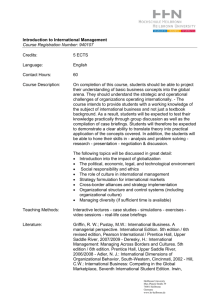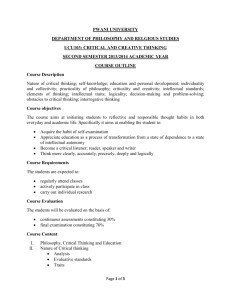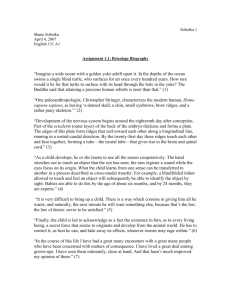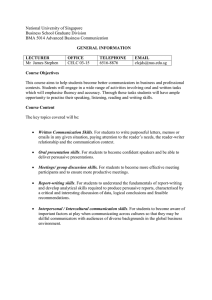x 1
advertisement
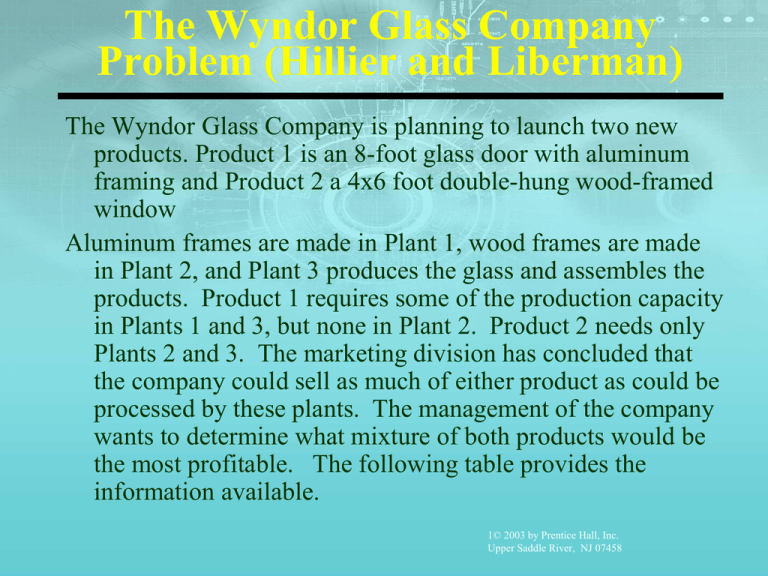
The Wyndor Glass Company Problem (Hillier and Liberman) The Wyndor Glass Company is planning to launch two new products. Product 1 is an 8-foot glass door with aluminum framing and Product 2 a 4x6 foot double-hung wood-framed window Aluminum frames are made in Plant 1, wood frames are made in Plant 2, and Plant 3 produces the glass and assembles the products. Product 1 requires some of the production capacity in Plants 1 and 3, but none in Plant 2. Product 2 needs only Plants 2 and 3. The marketing division has concluded that the company could sell as much of either product as could be processed by these plants. The management of the company wants to determine what mixture of both products would be the most profitable. The following table provides the information available. 1© 2003 by Prentice Hall, Inc. Upper Saddle River, NJ 07458 The Wyndor Glass Company Problem (Hillier and Liberman) Plant 1 2 3 Profit per batch Production time per batch, hours Product 1 2 1 0 3 $3,000 0 2 2 $5,000 Production time available per week, hours 4 12 18 2© 2003 by Prentice Hall, Inc. Upper Saddle River, NJ 07458 The Wyndor Glass Company Problem Formulation Formulation as a linear programming problem Decision variables: x1 = Number of batches of product 1 produced per week x2 = Number of batches of product 2 produced per week Objective function: Maximize z = 3 X1 + 5X2 (in thousands of dollars) Subject to: x1 2x2 3x1+ 2x2 x1, x2 0 4 12 18 (Production Available in Plant 1) (Production Available in Plant 2) (Production Available in Plant 3) 3© 2003 by Prentice Hall, Inc. Upper Saddle River, NJ 07458 Montana Wood Products Problem Montana Wood Products manufacturers two-high quality products, tables and chairs. Its profit is $15 per chair and $21 per table. Weekly production is constrained by available labor and wood. Each chair requires 4 labor hours and 8 board feet of wood while each table requires 3 labor hours and 12 board feet of wood. Available wood is 2400 board feet and available labor is 920 hours. Management also requires at least 40 tables and at least 4 chairs be produced for every table produced. To maximize profits, how many chairs and tables should be produced? 4© 2003 by Prentice Hall, Inc. Upper Saddle River, NJ 07458 Montana Wood Products Problem Formulation Objective Function Max Z = 15x1 + 21x2 Subject To 4x1 + 3x2 < 920 ( labor constraint) 8x1 + 12x2 < 2400 ( wood constraint) x2 - 40 > 0 (make at least 40 tables) x1 - 4 x2 > 0 (at least 4 chairs for every table) x1 , x 2 > 0 (non-negativity constraints) 5© 2003 by Prentice Hall, Inc. Upper Saddle River, NJ 07458 The Sureset Concrete Company Problem • The Sureset Concrete Company produces concrete. Two ingredients in concrete are sand (costs $6 per ton) and gravel (costs $8 per ton). Sand and gravel together must make up exactly 75% of the weight of the concrete. Also, no more than 40% of the concrete can be sand and at least 30% of the concrete be gravel. Each day 2000 tons of concrete are produced. To minimize costs, how many tons of gravel and sand should be purchased each day? 6© 2003 by Prentice Hall, Inc. Upper Saddle River, NJ 07458 The Sureset Concrete Company Problem Formulation Objective Function Min Z = 6x1 + 8x2 Subject To x1 + x2 = 1500 ( mix constraint) x1 < 800 ( mix constraint) x2 > 600 ( mix constraint ) x1 , x2 > 0 (non-negativity constraints) 7© 2003 by Prentice Hall, Inc. Upper Saddle River, NJ 07458 Widgets Problem Suppose a company produces two types of widgets, manual and electric. Each requires in its manufacture the use of three machines; A, B, and C. A manual widget requires the use of the machine A for 2 hours, machine B for 1 hour, and machine C for 1 hour. An electric widget requires 1 hour on A, 2 hours on B, and 1 hour on C. Furthermore, suppose the maximum numbers of hours available per month for the use of machines A, B, and C are 180, 160, and 100, respectively. The profit on a manual widget is $4 and on electric widget it is $6. See the table below for a summary of data. If the company can sell all the widgets it can produce, how many of each type should it make in order to maximize the monthly profit? Manual Electric A B C profit 2 1 1 $4 1 2 1 $6 Hours available 180 160 8© 2003 by Prentice Hall, Inc. 100 Upper Saddle River, NJ 07458 Widgets Problem Formulation X1 = number of manual widgets X2 = number of electric widgets Objective Function max Z = 4X1 + 6X2 ٍٍ Subject To 2X1 + X2 180 X1+ 2X2 160 X1+ X2 100 X1 0, X2 0 9© 2003 by Prentice Hall, Inc. Upper Saddle River, NJ 07458 Product-Mix Problem The Handy-Dandy Company wishes to schedule the production of a kitchen appliance which requires two resources – labor and material. The company is considering three different models of this appliance and its engineering department has furnished the following data: Resources required Product/Model to produce 1 unit A B C Labour (hours/unit) 7 3 6 Material (lbs./unit) 4 4 5 Profit ($/unit) 4 2 3 Resources Available 150 200 The supply of raw materials is restricted to 200 pounds per day. The daily availability of manpower is 150 hours. Formulate a linear programming model to determine the daily production rate of the various models of appliances in order to maximize the total 10© 2003 by Prentice Hall, Inc. Upper Saddle River, NJ 07458 profit. Product-Mix Problem Formulation XA= daily production of model A XB= daily production of model B XC= daily production of model C Objective Function Maximize Z = 4XA + 2XB + 3XC subject to the constrains 7XA + 3XB + 6XC 150 4XA + 4XB + 5XC 200 XA 0, XB 0, XC 0 11© 2003 by Prentice Hall, Inc. Upper Saddle River, NJ 07458 An Electric Company Problem • An electric company manufacturers two radio models, each on a separate rate production line. The daily capacity of the first line is 60 radios and that of the second is 75 radios. Each unit of the first model uses 10 pieces of a certain electronic component, whereas each unit of the second model requires 8 pieces of the same component. The maximum daily availability of the special component is 800 pieces. The profit per unit of models 1 and 2 is $30 and $20, respectively. Determine the optimum daily production of each model. 12© 2003 by Prentice Hall, Inc. Upper Saddle River, NJ 07458 An Electric Company Problem Formulation X1 = number of radios of model 1 X2 = number of radios of model 2 Objective Function max Z =30X1 + 20X2 ٍٍ Subject To X1 60 X2 75 10 X1+8X2 800 X1 0, X2 0 13© 2003 by Prentice Hall, Inc. Upper Saddle River, NJ 07458 Furniture Factory Problem • A small furniture factory manufacturers tables and chairs. It takes 2 hours to assemble a table and 30 minutes to assemble a chair. Assembly is carried out by four workers on the basis of a single 8-hour shift per day. Customers usually buy at least four chairs with each table, meaning that the factory must produce at least four times as many chairs as tables. The sale price is $150 per table and $50 per chair. Determine the daily production mix of chairs and tables that would maximize the total daily revenue to the factory. 14© 2003 by Prentice Hall, Inc. Upper Saddle River, NJ 07458 Furniture Factory Problem Formulation X1 = number of tables X2 = number of chairs Objective Function max Z =150X1 + 50X2 ٍٍ Subject To X2 - 4X1 0 120 X1+30X2 4x8x60 X1 0, X2 0 15© 2003 by Prentice Hall, Inc. Upper Saddle River, NJ 07458 Giapetto’s Woodcarving Problem • Giapetto’s, Inc., manufactures wooden soldiers and trains. Each soldier built: Each train built •Sell for $27 and uses $10 worth of raw materials. •Giapetto’s variable labor/overhead costs by $14. •Requires 2 hours of finishing labor. •Requires 1 hour of carpentry labor •Sell for $21 and used $9 worth of raw materials. •Giapetto’s variable labor/overhead costs by $10. •Requires 1 hour of finishing labor. •Requires 1 hour of carpentry labor. Each week Giapetto can obtain: all needed raw material, only 100 finishing hours & only 80 carpentry hours. Demand for the trains is unlimited, at most 40 soldiers are bought each week. Giapetto wants to maximize weekly profit. Formulate a mathematical model of Giapetto’s situation that can be used to maximize 16© 2003weekly by Prentice Hall,profit. Inc. Upper Saddle River, NJ 07458 Giapetto’s Woodcarving Problem Formulation x1 = number of soldiers produced each week x2 = number of trains produced each week Weekly profit = weekly revenue – weekly raw material costs – the weekly variable costs = 3x1 + 2x2 • objective function Maximize z = 3x1 + 2x2 • Subject to • 2 x1 + x2 ≤ 100 • x1 + x2 ≤ 80 • x1 ≤ 40 • x1 ≥ 0, x2 ≥ 0 (finishing constraint) (carpentry constraint) (constraint on demand for soldiers) 17© 2003 by Prentice Hall, Inc. Upper Saddle River, NJ 07458 Graphical Solution of an LP Problem • Used to solve LP problems with two (and sometimes three) decision variables • Consists of two phases • Finding the values of the decision variables for which all the constraints are met (feasible region of the solution space) • Determining the optimal solution from all the points in the feasible region (from our knowledge of the nature of the optimal solution) 18© 2003 by Prentice Hall, Inc. Upper Saddle River, NJ 07458 Finding the Feasible Region (2D) • Steps • Use the axis in a 2-dimensional graph to represent the values that the decision variables can take • For each constraint, replace the inequalities with equations and graph the resulting straight line on the 2dimensional graph • For the inequality constraints, find the side (half-space) of the graph meeting the original conditions (evaluate whether the inequality is satisfied at the origin) • Find the intersection of all feasible regions defined by all the constraints. The resulting region is the (overall) feasible region. 19© 2003 by Prentice Hall, Inc. Upper Saddle River, NJ 07458 Equation Form Basic data Tons of raw material per ton of Exterior paint Raw material, M1 Raw material, M2 Profit per ton ($1000) 6 1 5 Interior paint 4 2 4 Maximum daily availability (tons) 24 6 *Decision variables: Need to determine the amounts to be produced of exterior and interior paints. x1 = tons produced daily of exterior paint x2 = tons produced daily of interior paint *Objective (goal) aims to optimize: The company wants to increase its profit as much as possible. z represents the total daily profit (in thousands of dollars) Maximize z = 5x1 + 4x2 *Constraints: Restrict raw materials usage and demand (Usage of a raw material) ≤ (Maximum raw material) by both paints availability 6x1 + 4x2 ≤ 24 (Raw material M1) x1 + 2x2 ≤ 6 (Raw material M2) -x1 + x2 ≤ 1 (Demand Limit) x2 ≤ 2 (Demand Limit) 20© 2003 by Prentice Hall, Inc. Nonnegativity restrictions: x1, x2 ≥ 0 Upper Saddle River, NJ 07458 Graphical LP Solution Graphical procedure includes 2 steps Determination: 1) The solution space that defines all feasible solutions of the model 2) The optimum solution from among all the feasible points in the solution space Nonnegativity constraints Step 1: Determination of the Feasible Solution Space x1 ≥ 0 x2 x2 ≥ 0 first quadrant 6 Replace each inequality (≤) with equations (=) 6x1 + 4x2 ≤ 24 6x1 + 4x2 = 24 5 4 x1 + 2x2 ≤ 6 x1 + 2x2 = 6 -x1 + x2 ≤ 1 x2 ≤ 2 -x1 + x2 = 1 x2 = 2 3 Determine 2 points 6x1 + 4x2 = 24 let x1 = 0, x2 = 6 let x2 = 0, x1 = 4 2 points: (0,6) and (4,0) 2 1 0 2 3 4 1 2 3 4 5 6 21© 2003 by Prentice Hall, Inc. Graph of equations Upper Saddle River, NJ 07458 x1 1 Feasible Space Reference point Convenient computationally: (0,0) Note: select another point if the line passes through the origin, can’t use (0,0) Ex: 6x1 + 4x2 ≤ 24 Feasible half-space (0,0) 6 x 0 + 4 x 0 = 0 (0 ≤ 24) Not a feasible side (6,0) 6 x 6 + 4 x 0 = 36 (36 ≥ 24) x2 6 5 4 Constraints: 3 x1 + 2x2 ≤ 2 1 0 1 6 2 1 3 24 0 5 0 6 6x1 + 4x2 ≤ 24 Solution space 1 2 -x1 + x2 ≤ x2 ≤ x1 4 5 6 3 Feasible space of the Reddy Mikks model 22© 2003 by Prentice Hall, Inc. Upper Saddle River, NJ 07458 x1 ≥ x2 ≥ Optimum Solution Step 2: Determination of the Optimum Solution The feasible space consists of an infinite number of points Optimum solution: identify the piont in which the profit function z = 5x1 + 4x2 increases (maximize z).. Values of x1 and x2 associated with the optimum point 6x1 + 4x2 = 24 solve x1 + 2x2 = 6 simultaneously x1 = 3 and x2 = 1.5 z = 21 x2 3 x1 + 2x2 ≤ 6 Optimum: x1 = 3 tons x2 = 1.5 tons z = $21,000 2 6x1 + 4x2 ≤ 24 1 0 1 2 3 4 x1 23© 2003 by Prentice Hall, Inc. Upper Saddle River, NJ 07458 Reddy Mikks Problem Formulation 24© 2003 by Prentice Hall, Inc. Upper Saddle River, NJ 07458 Reddy Mikks Problem Solution Constraint 2: 2XE + XI 8 Constraint 3: -XE + XI 1 I Constraint 4: XI 2 Constraint 1: XE + 2XI 6 Feasible Region 1 2 3 4 5 6 7 0 + 2(0) 6 25© 2003 by Prentice Hall, Inc. Upper Saddle River, NJ 07458 E Example(2) • Objective Function Minimize z = 3x – y • Subject to x– y1 x+ y5 x 0, and y 0. 26© 2003 by Prentice Hall, Inc. Upper Saddle River, NJ 07458 Example(2)\solution vertex value of z at vertex (0, 0) (1, 0) (3, 2) (0, 5) z = 3(0) – (0) = 0 z = 3(1) – (0) = 3 z = 3(3) – (2) = 7 z = 3(0) – (5) = –5 x y 1 y (0, 5) (3, 2) x (1, 0) x y 5 The minimum value of z is –5 and this occurs at (0, 5). 27© 2003 by Prentice Hall, Inc. Upper Saddle River, NJ 07458
